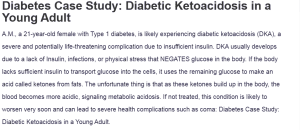Diabetes Case Study: Diabetic Ketoacidosis in a Young Adult
A.M., a 21-year-old female with Type 1 diabetes, is likely experiencing diabetic ketoacidosis (DKA), a severe and potentially life-threatening complication due to insufficient insulin. DKA usually develops due to a lack of Insulin, infections, or physical stress that NEGATES glucose in the body. If the body lacks sufficient insulin to transport glucose into the cells, it uses the remaining glucose to make an acid called ketones from fats. The unfortunate thing is that as these ketones build up in the body, the blood becomes more acidic, signaling metabolic acidosis. If not treated, this condition is likely to worsen very soon and can lead to severe health complications such as coma: Diabetes Case Study: Diabetic Ketoacidosis in a Young Adult.
A.M.’s symptoms of hyperglycemia, dehydration, and altered breathing pattern align closely with DKA. Initial findings include serum glucose 657mg/dL, positive urine ketones, and K 6.2 mEq/L. It is generally linked to acidosis and dehydration in DKA (Lizzo et al., 2023). She cannot take fluids because of nausea and vomiting; hence, she gets easily dehydrated and cannot take insulin. Her recent high readings on the glucometer, along with tachypnea characterized by rapid and deep respirations (36 breaths per minute) associated with a fruity odor, suggest DKA. This type of respiration is referred to as Kussmaul respirations and represents an attempt by the body to compensate for acidosis by blowing off carbon dioxide.
The etiology in A.M.’s case includes a combination of infection, missed insulin doses, and inability to maintain proper hydration. She cannot control her blood glucose level and has contracted severe hyperglycemia along with dehydration. Severe hyperglycemia presents a symptom of protracted thirst, less urination, ataxia, somnolence, and electrolyte imbalance, which needs immediate medical concern as it may impede the further progression of DKA (Gosmanov et al., 2021).
Immediate priorities for treatment include the administration of insulin, which will contribute to reducing hyperglycemia; the replacement of fluids, which will help counteract dehydration; and the close monitoring of electrolyte levels, especially potassium. The institution of insulin therapy can cause potassium to move into the cells and hypokalemia to occur, creating further complications. The importance of timely treatment is that it may help avoid worsening acidosis, severe electrolyte imbalance, cardiovascular complications, and even coma (Sullivan, 2019). This case reinforces the importance of teaching patients about managing their diabetes when ill. Teaching the patient about fluid intake, glucose monitoring, and the signs of DKA may avoid complications in the future.
References
Gosmanov, A. R., Gosmanova, E. O., & Kitabchi, A. E. (2021). Hyperglycemic crises: Diabetic ketoacidosis (DKA), and hyperglycemic hyperosmolar state (HHS). National Library of Medicine; Endotext. https://www.ncbi.nlm.nih.gov/books/NBK279052/
Lizzo, J. M., Goyal, A., & Gupta, V. (2023, July 10). Adult diabetic ketoacidosis. PubMed; StatPearls Publishing. https://www.ncbi.nlm.nih.gov/books/NBK560723/
Sullivan, D. D. (2019). Debra D. Sullivan – Guide to clinical documentation (2019).pdf. Google Docs. https://drive.google.com/file/d/1wdxvMa9uvmxMbEjZ0PmEclMbb-1KGh2h/view?usp=sharing
ORDER A PLAGIARISM-FREE PAPER HERE
We’ll write everything from scratch
Question
Using the case study below, prepare a 1 page paper.
A 21-year old female (A.M.) presents to the urgent care clinic with symptoms of nausea, vomiting, diarrhea, and a fever for 3 days. She states that she has Type I diabetes and has not been managing her blood sugars since she’s been ill and unable to keep any food down. She’s only tolerated sips of water and juices. Since she’s also been unable to eat, she hasn’t taken any insulin as directed.
While helping A.M. from the lobby to the examining room you note that she’s unsteady, her skin is warm and flushed, and that she’s drowsy. You also note that she’s breathing rapidly and smell a slight sweet/fruity odor. A.M. has a challenge answering questions but keeps asking for water to drink.
You get more information from A.M. and learn the following:
- She had some readings on her glucometer which were reading ‘high’
- She vomits almost every time she takes in fluid
- She hasn’t voided for a day but voided a great deal the day before
- She’s been sleeping long hours and finally woke up this morning and decided to seek care
Vital Sign
- Temperature – 101.3° F (tympanic)
- Blood pressure – 88/46 mmHg
- Heart rate – 132 beats/minute
- Respiratory rate – 36 breaths/min, deep
- Oxygen saturation % (SpO2) – 91% on room air
Lab results
Serum glucose – 657 mg/dl
Serum potassium – 6.2 mEq/L
Urine ketones – Positive
- What is the disorder and its pathophysiology that you expect the health care provider to diagnose?
- Describe the etiology of the disorder A.M is experiencing.
- Identify and describe the clinical manifestations of the disorder A.M. is experiencing.
Diabetes Case Study: Diabetic Ketoacidosis in a Young Adult
Instructions:
- Summarize the questions above and formulate what may be happening with A.M.
- Use at least one scholarly source to support your findings. Examples of scholarly sources include academic journals, textbooks, reference texts, and CINAHL nursing guides. Be sure to cite your sources in-text and on a References page using APA format.
You can find useful reference materials for this assignment in the School of Nursing guide: https://guides.rasmussen.edu/nursing/referenceebooks
Have questions about APA? Visit the online APA guide: https://guides.rasmussen.edu/apa
Case study adapted from:
- Harding, M.M. & Snyder, J.S. (2015). Winningham’s critical thinking cases in nursing: Medical-surgical, pediatric, maternity, and psychiatric. Retrieved from: https://ebookcentral.proquest.com/lib/ras/detail.action?docID=2072336.
Resources:
- Sullivan, D. D. (2019). Guide to clinical documentation (3rd ed.). Philadelphia, PA: F. A. Davis.


